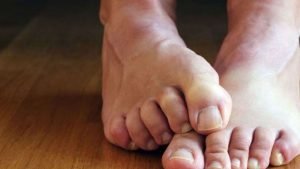Summary
Athlete’s foot, medically known as tinea pedis, is a skin condition that commonly affects the upper parts of the feet and the spaces between the toes. It is caused by the fungus Trichophyton, which thrives in warm and moist environments. This fungus is commonly found on floors and clothing, and its growth is accelerated on feet that remain damp for long periods, such as when wearing wet socks or shoes. It can also spread through direct contact with the skin of an infected individual.
The condition often presents with symptoms such as itching in the affected area, painful blisters between the toes, cracking or peeling of the skin, and a foul odor. These symptoms typically develop in areas where the fungus has taken hold, especially in warm and moist skin folds.
Athlete’s foot can be treated with over-the-counter antifungal creams or sprays. However, in severe cases, doctors may prescribe stronger topical or oral antifungal medications to effectively eliminate the infection.
Table of Contents
Symptoms of Athlete’s Foot

Athlete’s foot, or tinea pedis, can cause a variety of symptoms that primarily affect the skin and nails of the feet. Below are the most common signs to watch out for:
- Itching and stinging sensations. These often occur between the toes or on the soles of the feet and may be accompanied by a burning feeling.
- Blisters on the feet. Intensely itchy blisters may form, which can sometimes break and lead to further irritation or infection.
- Cracking or peeling of the skin. This is particularly common between the toes or on the soles, where the skin becomes dry and prone to fissures.
- Dry or scaly skin. The soles or sides of the feet may appear excessively dry, flaky, or rough.
- Redness or inflammation. The affected areas may appear red or swollen, indicating irritation from the fungal infection.
- Changes in toenails. In some cases, the infection spreads to the toenails, causing them to become thickened, discolored, brittle, or detached.
These symptoms can vary in intensity and may worsen if left untreated. Recognizing these early signs can help prevent the condition from progressing to more severe stages.
Diagnostic Procedures for Athlete’s Foot
Accurate diagnosis of athlete’s foot is crucial to properly identify and treat the condition. Below are the common diagnostic methods used by healthcare professionals:
- Physical examination of the affected skin.
A healthcare specialist will examine the appearance of the skin to check for symptoms of athlete’s foot, such as scaling, redness, itching, and cracked skin between the toes or on the soles of the feet. These symptoms often serve as clear indicators of the condition. - Potassium hydroxide (KOH) test.
The specialist will collect a small sample of the affected skin and place it in a potassium hydroxide solution. This solution breaks down non-fungal elements in the sample, making fungal elements more visible under a microscope. This method is quick and commonly used to confirm a fungal infection. - Examination under ultraviolet (UV) light.
Certain types of fungal infections may fluoresce or show distinct colors under UV light. While not always used for athlete’s foot, the Wood’s lamp test can help identify specific types of fungi. - Fungal culture test.
In complex cases, a sample may be sent to a laboratory for fungal culture. This process involves growing the fungus to determine its exact type. Although it takes longer, it provides detailed and precise results. - Ruling out other conditions.
Some skin conditions, such as eczema, psoriasis, or contact dermatitis, may present symptoms similar to athlete’s foot. A thorough examination is performed to ensure that the symptoms are caused by athlete’s foot and not another condition.
Early diagnosis of athlete’s foot is essential to prevent the infection from worsening or spreading to other parts of the body or to other individuals. If athlete’s foot is suspected, consult a healthcare specialist immediately for proper diagnosis and treatment.
Complications of Untreated Athlete’s Foot
As a fungal infection, athlete’s foot can spread to other parts of the body if left untreated. Moreover, it can lead to various complications that may require more intensive medical attention. Below are some potential complications caused by untreated athlete’s foot:
- Fungal nail infections. Athlete’s foot can extend to the toenails, causing them to thicken, discolor, crack, or even detach. This condition, known as onychomycosis, is often harder to treat than the initial foot infection.
- Secondary bacterial infections. Prolonged athlete’s foot can lead to bacterial infections that cause swelling, pain, and warmth in the affected area.
- Lymph node infection. Bacteria or fungi can enter the body through open wounds or cracks in the skin, potentially leading to infection in the lymph nodes (lymphadenitis).
- Cellulitis. This bacterial skin infection affects the deeper layers of the skin and can cause redness, swelling, fever, and tenderness. If untreated, cellulitis can become life-threatening.
- Allergic reactions. Prolonged fungal infections can sometimes trigger allergic reactions in susceptible individuals, leading to further irritation or systemic effects.
Early treatment of athlete’s foot is crucial to prevent these complications. Prompt use of antifungal medications and maintaining proper foot hygiene can effectively manage the condition and reduce the risk of more severe infections.
Causes of Athlete’s Foot
Tinea versicolor is caused by the overgrowth of the fungus Malassezia, specifically Malassezia globosa, which naturally resides on the skin of most adults without causing any harm. Under normal conditions, this fungus coexists peacefully with the body’s other microorganisms. However, when it multiplies excessively, it disrupts the normal pigmentation of the skin, leading to the appearance of discolored patches characteristic of tinea versicolor.
The overgrowth of Malassezia interferes with the production of melanin, the pigment responsible for skin color. This results in patches of skin that are lighter or darker than the surrounding areas. The exact mechanism triggering the sudden proliferation of this fungus is not entirely understood, but it is the direct cause of tinea versicolor.
It’s important to note that tinea versicolor is not contagious. Since Malassezia is a fungus that naturally inhabits everyone’s skin, the condition arises from an imbalance in the skin’s natural flora rather than transmission from person to person.
Prevention of Athlete’s Foot

Preventing athlete’s foot involves maintaining proper hygiene and making mindful choices about footwear and personal habits. Below are some effective steps to reduce the risk of developing this condition:
- Use antifungal powder daily. Applying antifungal powder to your feet can help prevent fungal growth, especially in warm and moist conditions.
- Avoid sharing personal items. Do not lend or borrow socks, shoes, or towels, as these can carry fungal spores that lead to infection.
- Wash your feet thoroughly. Clean your feet daily with soap and clean water, paying special attention to the spaces between your toes. Dry them thoroughly using a clean towel.
- Launder items with warm water. Wash socks, towels, and even bed linens in warm water to kill any lingering fungi or bacteria.
- Disinfect footwear. Regularly use a disinfectant spray or solution on your shoes to eliminate any microbes that may reside inside.
- Wear slippers in public areas. Always use flip-flops or sandals in communal showers, swimming pools, and similar locations to minimize exposure to fungi.
- Choose breathable socks. Opt for socks made from materials like cotton or wool that wick moisture away from the skin.
- Wear comfortable footwear. Select shoes made from breathable materials that allow air circulation and reduce moisture build-up.
- Change socks if your feet sweat. Replace damp socks with dry ones during the day to prevent fungal growth.
- Air out your feet at home. Whenever possible, go barefoot at home to allow your feet to stay dry and breathe.
- Alternate your shoes. Rotate between pairs of shoes and ensure they are completely dry before wearing them again.
By following these simple yet effective practices, you can significantly lower the risk of athlete’s foot while maintaining healthy, comfortable feet.
Risk Factors for Athlete’s Foot

The truth is, anyone can develop athlete’s foot. However, certain habits and practices can significantly increase the risk of contracting this fungal infection. Below are some common factors that contribute to a higher likelihood of developing athlete’s foot:
- Walking barefoot in public areas. Frequenting communal places such as public dressing rooms, showers, and swimming pools without wearing protective footwear exposes the feet to fungi that thrive in these moist environments.
- Sharing personal items. Using or lending socks, shoes, or towels that belong to others can transfer the fungus, especially if the items come from someone with an existing infection.
- Wearing tight, closed-toe shoes. Footwear that restricts airflow and keeps the toes tightly enclosed creates a warm and moist environment ideal for fungal growth.
- Prolonged exposure to moisture. Keeping feet wet for long periods, such as wearing damp socks or shoes, fosters the conditions necessary for fungal infections.
- Excessive sweating of the feet. Individuals with sweaty feet are more prone to fungal infections as the moist conditions encourage fungal proliferation.
- Minor cuts or injuries on the feet. Small wounds or cracks in the skin or nails of the feet provide an entry point for fungi, increasing the risk of infection.
By understanding and addressing these risk factors, individuals can take proactive measures to protect themselves from athlete’s foot. Simple steps like maintaining good foot hygiene, wearing appropriate footwear, and avoiding shared personal items can go a long way in preventing this common condition.
Athlete’s Foot FAQs
Athlete’s foot is a common fungal infection, but many people have questions about its causes, treatment, and prevention. To help you better understand this condition, here are some frequently asked questions and their answers. These will provide insights into how to manage and avoid this infection effectively.
- Can athlete’s foot spread to other parts of the body?
Yes, athlete’s foot can spread to other areas, such as the hands, nails, or groin, if the infection is left untreated. This happens when fungal spores are transferred through scratching or contact with infected items. - Is athlete’s foot contagious?
Yes, athlete’s foot is highly contagious. It can spread through direct contact with an infected person or by touching contaminated surfaces, such as floors, towels, or shoes. - How long does it take to treat athlete’s foot?
Treatment duration depends on the severity of the infection. Mild cases may improve within one to two weeks of using over-the-counter antifungal treatments, while more severe cases may require prescription medications and can take several weeks to heal. - Can athlete’s foot come back after treatment?
Yes, recurrence is common if preventive measures, such as maintaining good foot hygiene and wearing breathable footwear, are not followed. Reinfection can also occur through exposure to the same fungal sources. - Can athlete’s foot heal without treatment?
Athlete’s foot rarely resolves on its own. Without treatment, the infection may worsen, spread to other areas, or lead to complications like bacterial infections or fungal nail infections. - Can I prevent athlete’s foot if I sweat a lot?
Yes, proper hygiene and care can reduce the risk. Change your socks frequently, use antifungal powders, and wear breathable footwear to manage excessive sweating. - Should I see a doctor for athlete’s foot?
For mild cases, over-the-counter treatments are often effective. However, if the infection persists, worsens, or spreads to other parts of the body, consult a healthcare provider for stronger treatments or further evaluation.


